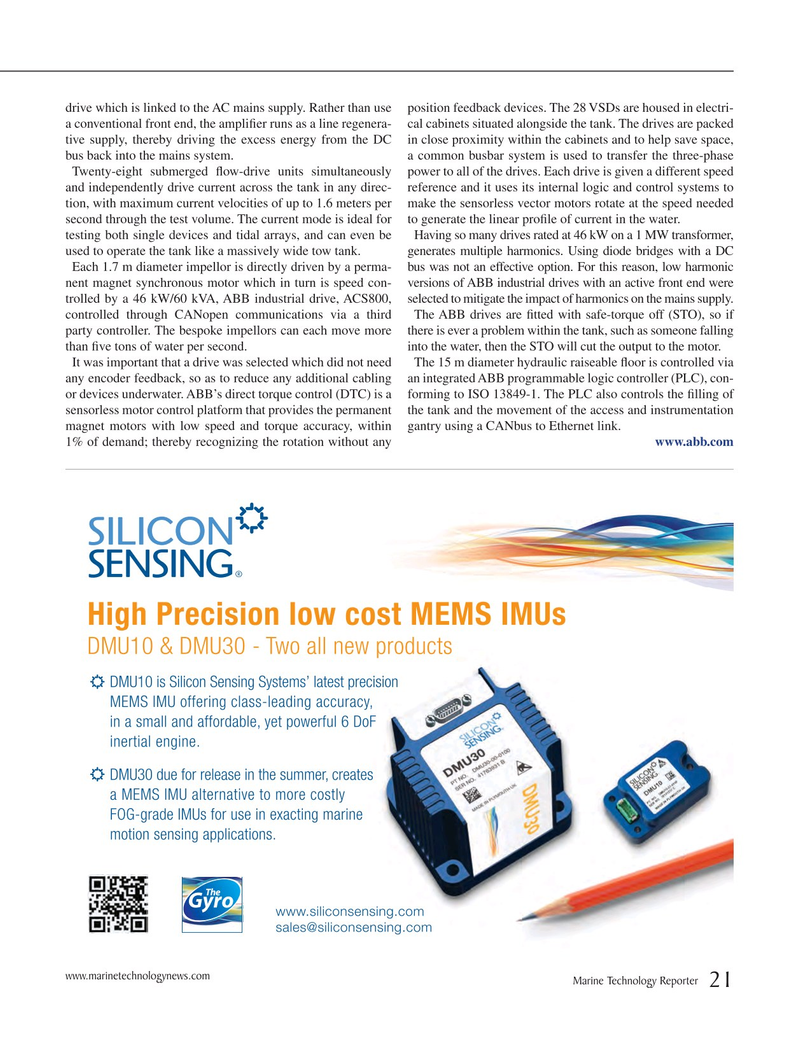
Page 21: of Marine Technology Magazine (June 2015)
Hydrographic Survey
Read this page in Pdf, Flash or Html5 edition of June 2015 Marine Technology Magazine
drive which is linked to the AC mains supply. Rather than use position feedback devices. The 28 VSDs are housed in electri- a conventional front end, the ampli? er runs as a line regenera- cal cabinets situated alongside the tank. The drives are packed tive supply, thereby driving the excess energy from the DC in close proximity within the cabinets and to help save space, bus back into the mains system. a common busbar system is used to transfer the three-phase
Twenty-eight submerged ? ow-drive units simultaneously power to all of the drives. Each drive is given a different speed and independently drive current across the tank in any direc- reference and it uses its internal logic and control systems to tion, with maximum current velocities of up to 1.6 meters per make the sensorless vector motors rotate at the speed needed second through the test volume. The current mode is ideal for to generate the linear pro? le of current in the water. testing both single devices and tidal arrays, and can even be Having so many drives rated at 46 kW on a 1 MW transformer, used to operate the tank like a massively wide tow tank. generates multiple harmonics. Using diode bridges with a DC
Each 1.7 m diameter impellor is directly driven by a perma- bus was not an effective option. For this reason, low harmonic nent magnet synchronous motor which in turn is speed con- versions of ABB industrial drives with an active front end were trolled by a 46 kW/60 kVA, ABB industrial drive, ACS800, selected to mitigate the impact of harmonics on the mains supply. controlled through CANopen communications via a third The ABB drives are ? tted with safe-torque off (STO), so if party controller. The bespoke impellors can each move more there is ever a problem within the tank, such as someone falling than ? ve tons of water per second. into the water, then the STO will cut the output to the motor.
It was important that a drive was selected which did not need The 15 m diameter hydraulic raiseable ? oor is controlled via any encoder feedback, so as to reduce any additional cabling an integrated ABB programmable logic controller (PLC), con- or devices underwater. ABB’s direct torque control (DTC) is a forming to ISO 13849-1. The PLC also controls the ? lling of sensorless motor control platform that provides the permanent the tank and the movement of the access and instrumentation magnet motors with low speed and torque accuracy, within gantry using a CANbus to Ethernet link.
1% of demand; thereby recognizing the rotation without any www.abb.com
High Precision low cost MEMS IMUs
DMU10 & DMU30 - Two all new products
DMU10 is Silicon Sensing Systems’ latest precision
MEMS IMU offering class-leading accuracy, in a small and affordable, yet powerful 6 DoF inertial engine.
DMU30 due for release in the summer, creates a MEMS IMU alternative to more costly
FOG-grade IMUs for use in exacting marine motion sensing applications.
www.siliconsensing.com [email protected] www.marinetechnologynews.com
Marine Technology Reporter 21
MTR #5 (18-33).indd 21 MTR #5 (18-33).indd 21 6/11/2015 1:59:38 PM6/11/2015 1:59:38 PM

 20
20

 22
22
